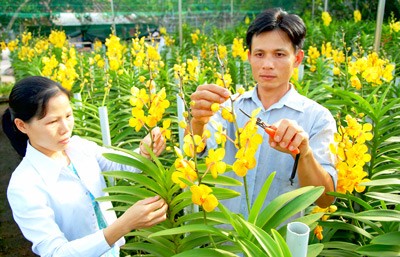(VOV) – Since the new rural development program was implemented 3 years ago, one third of communes in Cu Chi district, Ho Chi Minh City, have fulfilled all criteria. Cu Chi, heavily damaged by bombing during the war, is now becoming a highlight in the new rural development in suburban districts of Ho Chi Minh City thanks to efficient economic models. VOV’s Bich Huyen reports on recent changes in an area famous for its revolutionary tradition.
 |
| Farmers in Tan Thong Hoi hamlet, Cu Chi district grow orchids (Photo: Cao Thang) |
As Tet approaches, Tan Thong Hoi commune is becoming busier. On straight paved roads, farmers hurry to transport the last orchid pots to flower markets. This year local farms have yielded more orchids than usual. Thanks to previous market research, they had switched to growing Mokara orchids, a type with low production cost but in demand by consumers. Their happiness has doubled now that the commune has completed all 19 of the criteria for new rural development. Nguyen Linh, a resident of Tan Thong Hoi hamlet, said ‘Villagers of Tan Thong Hoi hamlet feel inspired as their hamlet was chosen to pilot the new rural development program. They can understand all policies of the government and local authorities while joining hands in the implementation process. Systems of transport, irrigation, and economic facilities are improving day by day.’
Thai My is another commune of Cu Chi district to have fulfilled 19 criteria. In the past, Thai My was one of the poorest communes of Ho Chi Minh City with per capita annual income around 816 USD. Now it has changed dramatically. Incomes have increased 180%. More than 24,000 agricultural laborers have moved into industry, trade, and service jobs. During this process, each step has been publicized for comments and public supervision, creating a link between the people and the administration. Tran Thanh Dung, a farmer from Thai My hamlet, said ‘Since the program was implemented, our living conditions have been stabilized. The government has financed paved roads to make travel easier. Local farmers have been taught to cultivate vegetables and rice and apply advanced technologies. The selling of products to cooperatives has become more stable.’
Under the national target program on new rural development until 2020, apart from 6 pilot communes, by 2015 Ho Chi Minh City plans to have an additional 22 new rural hamlets, and by 2020 all hamlets will satisfy the criteria on new rural areas. To realize this goal, the city has focused on developing jobs based on their advantages to material zones, the consumer market, the labor force, production technologies, and the preservation and development of craft villages. The city plans to generate 45,000 jobs and increase production value and the average income of rural laborers 15%. Le Thanh Liem, Director of the municipal Department of Agriculture and Rural Development, said ‘In fact, there remain challenges ahead as it’s a new model. The city’s steering committee will make an effort to do better in the next period. We’ll increase communications about the program, and provide training for commune personnel who will directly participate in the program. The process should be based on people and match the practical situation. The government will only invest in essential works to attract the participation of various economic sectors. We will draw lessons while implementing the program and conducting more studies.’
The hard working people of Cu Chi are gradually making their fortune in their homeland. The big suburban area is becoming a new rural district with a modern infrastructure underlying a traditional culture.
Bich Huyen